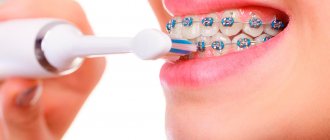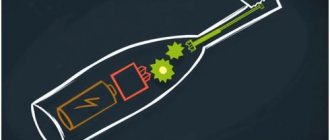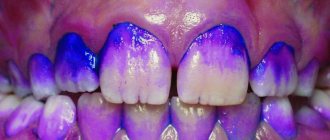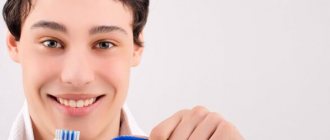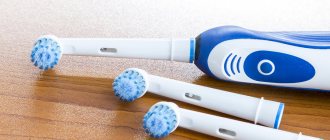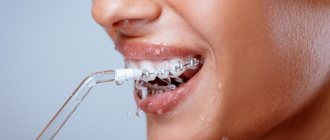Philips Sonicare electric brushes are considered one of the most technologically advanced. They allow you to quickly clean your mouth of food debris and get rid of plaque. Such devices are not cheap, so you need to learn how to use them.
In this article
- Philips Sonicare electric brushes: advantages and disadvantages
- How to choose a Philips electric toothbrush
- How to brush your teeth with a Philips brush
- How to care for your Philips Sonicare electric toothbrush
Let's learn how to properly brush your teeth with Philips brushes and how to care for them.
Manufacturers of electric toothbrushes regularly update their range of products and release new models every year. They are becoming more and more functional, convenient and practical. The popularity of such devices is also growing. Philips Sonicare electric brushes are in great demand.
They cost a little more than many other models, but, according to dentists, it is better not to skimp on hygiene products. Treating teeth or cleaning them from plaque in a clinic is much more expensive. Let's look at the advantages of Philips Sonicare brand brushes. After that, we will tell you how to use them so as not to harm your teeth and extend the life of the device.
Care and storage
There is nothing difficult about caring for an electric toothbrush. After brushing your teeth, the attachment must be thoroughly rinsed under running water; Once every 1–2 weeks, you can use an antibacterial rinse as a preventative measure. For the same purpose, the handle should be wiped from time to time with a sponge soaked in antiseptic and wiped dry.
Many attachments have special bristles that become discolored over time, signaling that it is time to change the attachment. The nozzle is changed with the same regularity as a regular manual brush - once every 3 months or immediately after an infectious disease.
Brushes are stored in a vertical position, on an open and ventilated surface. Cases and caps are intended for transportation only; brushes cannot be stored in them permanently. The brush must be well dried so that the bristles do not create an environment for the growth of bacteria and fungi.
If you have a shared bathroom, the brush should be stored in a cabinet, since when the water is flushed, an aerosol cloud with bacteria and tiny particles of human waste products rises above the toilet. Its size reaches 2 meters.
General characteristics
Any of the brushes in the Sonicare linear range has vibrating bristles (frequency - 1.7 MHz), which allows them to penetrate to a depth of about 4 mm between the gums and teeth and provides effective cleaning, the ability to remove tartar from invisible parts of the teeth and protects against cervical caries .
The cleaning technology is as follows: the plaque is whipped into foam by vibration, which breaks its connection with the enamel. Also, ultrasonic exposure destroys most microorganisms that can cause oral diseases.
In addition, a huge advantage is better cleansing of the enamel, tongue, and walls of the oral cavity .
With the use of the Philips Sonicare line, cleaning becomes possible without the use of pastes and powders or with a small amount of them (about half the usual dosage or less).
Based on the listed characteristics, we can highlight the main advantages of using this product:
- careful surface cleaning,
- possibility of teeth whitening without the use of chemicals,
- noticeable results after just two weeks of use,
- long-term operation (about 6 years).
We'll figure out which electric toothbrush to choose in a new publication.
In the next article we will tell you what to do if a piece of your front tooth breaks off.
Here https://www.vash-dentist.ru/krasota-i-uxod/zubnyie-shhetki/curaprox-opisanie-preimushhestva-za-kakuyu-tsenu-mozhno-kupit.html you will find reviews about the Curaprox toothbrush.
So, the Philips Sonicare lineup includes :
- DiamondClean HX9352/04 Black Edition, DiamondClean HX9332/35 White Edition.
- FlexCare PLATINUM HX9122/12.
- HealthyWhite HX6711/02.
- HealthyWhite+ HX8911/02.
- 2 Series HX6231/01.
- 3 Series X6631/01.
- EasyClean HX6511/02 (HX6511/35).
- CleanCare+ HX3212/03.
- PowerUp HX3110/33.
Unique is the fact that the warranty card for brushes is international. What other company offers this?
Teeth brushing technique
Brushing your teeth with an electric toothbrush is much easier than with a manual toothbrush because it does half the work for you. The bristles need to be moistened with water and a pea-sized amount of paste applied to it, as on a regular brush. Mentally divide your jaw into four sectors - each should take at least 30 seconds to cleanse.
And then the differences begin. There is no need to make sweeping movements - just move the brush smoothly from tooth to tooth.
If you have a brush with a round attachment , the bristles should cover one tooth completely from different sides. Clean the outer surface of the tooth first, then move to the inner surface and finish with chewing. Apply gentle pressure from above to clean between teeth. Pause on each tooth for 3-4 seconds.
If you have a brush with an oval attachment , place it at an angle of 45° to the surface of the teeth. The brush head should cover 2 teeth. Smoothly move it along the dentition, first on the outer, then on the inner and chewing surface.
The bristles should touch not only the teeth, but also the gums. Many brushes are equipped with a pressure sensor - if yours does not, be careful not to press too hard on the brush and injure your gums.
HealthyWhite
This toothbrush model has all the advantages of the Sonicare model line:
- excellent cleaning effect thanks to 31 thousand bristles movement in 1 minute,
- action on plaque , especially in hard-to-reach places, which is achieved thanks to a dynamic fluid flow consisting of a mixture of paste, saliva and oxygen.
- the presence of a timer that controls the cleaning time of each square of the oral cavity.
- presence of an addiction mode - the brush will change the intensity of its work from the first day to make it easier to get used to the new device.
- the ability to care for your teeth in three different modes : standard cleaning, delicate and with whitening.
It can be purchased at a price of about 6,500 rubles. When compared with manual brushes, the effect is 100% higher.
The Philips HealthyWhite HX 6711/02 head is ergonomic due to the rounded bristles and does not damage the enamel and gums. Can also be used by those who wear various orthodontic structures.
The main features are:
- Smoothness of the bristles relief.
- Easy-to-use angle of inclination of nozzles.
- The battery should be charged every 10 days. You can transport the brush while traveling in the case that is included in the package.
How to properly brush children's teeth?
A child can be introduced to an electric toothbrush from the age of 3 years. But up to 7, you should guide the brush and not let go of it while brushing. During this period, it is important to teach the child to spit the toothpaste and rinse his mouth.
The technique of brushing teeth in adults and children is no different - the only difference is that parents help children brush their teeth. Sit in a way that is comfortable for both of you: sit the child on your lap or stand behind him in front of the mirror. If your brush does not have a built-in two-minute timer, use a special application that will motivate and captivate the child (for example, some applications gradually open a picture of cartoon characters while brushing teeth).
series Rechargeable sonic toothbrush…
Healthywhite
- Image
- Text
- Content
HealthyWhite
700 series
Rechargeable
sonic toothbrush
- English Important Danger
- Warning
- Caution
- Electromagnetic fields (EMF)
- Changing the color code ring
- Brushing instructions Clean and White mode brushing instructions
- Clean mode
- Easy-start Deactivating or activating the Easy-start feature
- Toothbrush handle
- Brush head
- Removing the rechargeable battery
- Guarantee restrictions Fare
- Vigtigt Elektromagnetiske felter (EMF)
- Udskiftning af farvekode-ring
- Børstevejledning Børstevejledning til Clean and White-indstilling
- Clean-indstilling
- Easy-start Deaktivering eller aktivering af Easy-start
- Tandbørstens håndtag
- Borstehoved
- Udtagning af det genopladelige batteri
- Gældende forbehold i reklamationsretten Peligro
- Importante Campos electromagneticos (CEM)
- Cómo cambiar el aro de código de color
- Instrucciones de cepillado Instrucciones de cepillado en el modo Clean & White
- Modo Clean (Limpieza)
- Easy-start Cómo desactivar o activar la función Easy-start
- Mango del cepillo
- Cabezal del cepillo
- Cómo extraer la batería recargable
- Restricciones de la garantía Vaara
- Tärkeää Sähkömagneettiset kentät (EMF)
- Värirenkaan vaihtaminen
- Harjausohjeet Puhdas ja valkoinen -tilassa harjaaminen
- Puhdistustila
- Easy-start Easy-start-toiminnon ottaminen käyttöön tai poistaminen käytöstä
- Hammasharjan runko
- Harjaspää
- Akun poistaminen
- Takuun rajoitukset Pericolo
- Importante Campi elettromagnetici (EMF)
- Sostituzione della ghiera colorata
- Istruzioni d'uso Istruzioni d'uso in modalità pulizia e sbiancamento
- Modalità pulizia
- Easy-start Disattivazione/attivazione della funzione Easy-start
- Manico dello spazzolino
- Testina
- Rimozione della batteria ricaricabile
- Limitazioni della garanzia Fare
- Viktig Elektromagnetiske felt (EMF)
- Bytte ring med fargecode
- Børsteinstruksjoner Pusseinstruksjoner for ren-og-hvit-modus
- Rengjøringsmodus
- Easy-start Deaktivere eller aktivere Easy-start-funksjonen
- Tannbørstehåndtak
- Borstehode
- Fjerne det oppladbare batteriet
- Begrensninger i garantien Perigo
- Importante Campos Electromagnéticos - EMF (Electro Magnetic Fields)
- Mudar o anel colorido
- Instruções de escovagem Instruções para o modo de escovagem Clean and White
- Modo Clean
- Easy-start Activar ou desactivar a função Easy-start
- Pega da escova de dentes
- Cabeça da escova
- Retirar a bateria recarregável
- Restrições à garantia Dangerous
- Caution Electromagnetic fields (EMF)
- Color coded ring change
- Cleaning tips Clean and White cleaning tips
- Cleaning mode
- Easy-start function Enable or disable the Easy-start function
- Toothbrush handle
- Brush attachment
- Removing the Battery
- Fara Warranty Limitation
- Viktigt Elektromagnetiska fält (EMF)
- Byte av färgkodad ring
- Borstningsanvisningar Borstningsinstruktioner för rengörings- och vitläget (Clean och White)
- Rengöringsläge (Clean)
- Easy-start Avaktivera eller aktivera Easy-start-funktionen
- Tandborsthandtag
- Borsthuvud
- Ta ut det laddningsbara batteriet
- Garantibegränsningar
How to charge the brush
A new brush must be charged to its full capacity - the full charging time is indicated by the manufacturer in the instructions and can take up to 48 hours. Charging time depends on the battery capacity and other technical characteristics of the brush.
Many brushes have a charging indicator, which will help you understand the current state of the battery. If your brush has a nickel-metal hydride battery, you should charge it only after it is completely discharged. Brushes with lithium-ion batteries can be charged at any charge level.
When charging, the brush must be in a vertical position. It is best to charge the brush directly from the mains, without using intermediate devices such as a power bank or tablet - this is not only faster, but also safer.
Equipment
At first glance at the weighty packaging, it becomes clear that DiamondClean Smart is a serious device, before using which you need to carefully study the instructions and understand each item in the box. The kit includes: a handle (brush base), four different attachments with a case, a brush case, instructions, a charging cup and the charging station itself.
The shockproof carrying case deserves special attention. The hidden compartment contains a USB charger, so the brush can be recharged while traveling from any laptop or a regular 5 V and 1 A plug for a smartphone. The case holds the brush handle, as well as two attachments. This case is a good option for business trips and city travel, but it’s still not very convenient to take it on a hike: it looks like a case for giant glasses and takes up quite a lot of space in the bag.
Ninth step
Check if the toothbrush is dry, and if the answer to this question is yes, place it on a special stand. If the brush's charge is low, it is recommended to place it in the charging station in a timely manner so that the device is fully ready for use by the next time you brush your teeth. If the brush is set to recharge, we recommend that you monitor the charging process by turning off the gadget in a timely manner, because excessive charging installation time will not benefit the brush.
Contraindications for use
In addition to the benefits and pleasure of use, electric brushes also have a number of contraindications and disadvantages :
- Before you start using the device, it is advisable to obtain the approval of your dentist, who will evaluate the condition of your teeth. You will also receive the necessary advice and recommendations.
- Those people who have sore or weak gums are not recommended to use an electric toothbrush every day. You can alternate it with a manual analogue and monitor your well-being.
- Thin, sensitive enamel can also be damaged by thorough cleansing with an electric brush.
- The use of an electric toothbrush is contraindicated for people with serious heart disease.
- The main disadvantage of the device is the high cost of the device itself and the attachments, which must be changed regularly.
Precautionary measures
If you have chosen an electric brush for daily oral care, then do not forget about the need to constantly monitor the pressure of the device on the tissue of the gums and teeth.
It is important to know that excessive force can cause soft tissue injury or damage to the enamel layer of the teeth.
To save money, we recommend purchasing one device for the whole family . Only individual nozzles will have to be changed.
For those who care about the cleanliness and health of their teeth, dentists recommend using electric or sonic brushes. As you can see, using such a device is simple and convenient. With the help of our tips, you will master the art of competent hygienic oral care. And perhaps, once you try an electric brush, you will never go back to using a manual one.
Philips Sonicare Sonic Toothbrush –
The Philips Sonicare sonic toothbrush is the most popular such device, and the manufacturing company offers for purchase - well, just a huge number of different models. We will not talk about all the models, but we will write the most important thing: what you really need and what you can refuse. The most important indicator will be the number of oscillatory movements per minute, which in toothbrushes for adults can be either 62,000 or 31,000 (for older models).
Philips Sonicare brush (using the example of the “Protective Clean 6100” model):
Brushes that make 31,000 vibrations per minute are quite cheap - from about 3,500 rubles. These brushes have the advantage of not having a lot of electronics, and are therefore more reliable than the latest Philips Sonicare brushes. But you need to keep in mind that one of the main disadvantages of sonic toothbrushes is the high risk of a drop in the device’s power (we’ll talk about this below). And therefore, it is initially better to purchase a more powerful device.
The second main point, but again it is important specifically for buyers of more powerful brushes. Sonic toothbrushes produce a very strong vibration, and a person who is not used to brushing their teeth with such a brush will simply find it unpleasant. Therefore, it is optimal if your brush has 3 power levels - intense, medium and soft. This will allow you to adapt your brush to any task, including making it easier to get used to it (24stoma.ru).
As for the number of cleaning modes, you will only need 1 of the most important standard “Clean” modes. All other modes, for example, the “whitening” mode and others, can be abandoned, because In principle, this is just marketing for which you overpay. Let us repeat once again - the most important thing is that the Philips Sonicare sonic brush has the ability to change power levels and makes exactly 62,000 vibrations per minute at the maximum level.
Some important points:
We will also point out that you may notice in the description of the devices that one brush removes up to 7 times more plaque, and the other - up to 10 times more (we are comparing different brush models, all of which perform 62,000 strokes per minute). So, the difference will depend not on the brush, but on the attachment that comes with the kit. It's just that different Philips Sonicare brush heads remove plaque differently. The best attachment from Philips Sonicare is the “C3 Premium Plaque Control”, the others will remove plaque a little worse.
Here it must be said that any Philips Sonicare attachments are suitable for absolutely all models of brushes from this company. Those. if you buy a simpler model of a Philips Sonicare electric toothbrush (with a different type of replacement brush heads included), you can then simply buy the “C3 Premium Plaque Control” heads and use only them.
Another important point is that on some models the charger is made in the form of a transparent glass cup, which, when dropped on a tile, breaks into 1000 small fragments, and in this case you will have to charge the brush only via USB, which is equipped with the case. Therefore, it is best to buy brush models equipped with a traditional plastic charger. We hope that our recommendations will be useful to you.
Philips Sonicare toothbrush: reviews
I personally bought a Philips Sonicare Protective Clean 6100 toothbrush. You can see this brush in the photo and video in this section. Its most important characteristic is that it makes 62,000 sweeping movements per minute. I bought this brush as a gift for my mom to replace the old Philips Sonicare sonic brush that my mom had been using for the last 3-4 years. According to the instructions, this outdated brush model only made 31,000 sweeping movements per minute.
Philips Sonicare Protective Clean 6100 brush –
After the first use, my mother noticed a significant difference between these brushes, saying that the new brush cleans teeth much better than the old one. As of September 2022 - she has been using this brush for about 8 months, and during this time no technical problems have arisen with it, and the “patient” was very satisfied with this device. Therefore, I can leave a positive review for Philips Sonicare.
What do the numbers after the name say?
The digital and alphabetic coding that follows the name of the device - for example, HX3212/03 or HX6232/20, etc., is information for employees and sellers at retail outlets. The encoding combines a lot of data - model modification, handle, batch number, etc. Such marking simplifies the accounting of goods - after all, a digital code is much easier to track than a name, which may be incorrectly translated into other languages. It also simplifies checking for the sale of non-original (counterfeit) goods.


